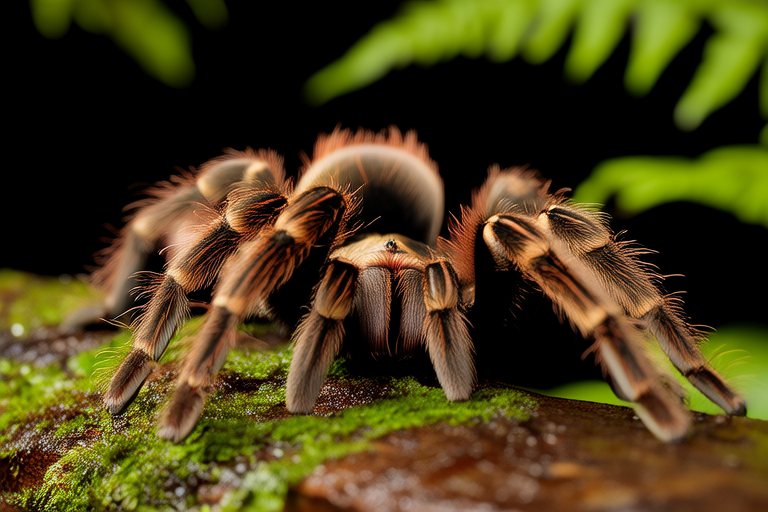Tarantula Care Tips: Expert Advice for First-Time Arachnid Owners
Welcome to the fascinating world of tarantulas! These captivating arachnids make wonderful pets for those who appreciate unique creatures. Before diving into tarantula ownership, it’s crucial to understand their specific needs and how to provide a safe and comfortable environment. This guide offers expert advice to help you care for your new pet effectively.
Understanding Tarantulas
Tarantulas belong to the family Theraphosidae and are known for their large size and hairy appearance. They come in various species, each with distinct characteristics, making them intriguing subjects for observation. Some species can live up to 20 years or more, so it’s important to be prepared for long-term commitment.
Suitable Habitat Setup
The first step in setting up your tarantula’s home is choosing an appropriate enclosure. A glass aquarium or plastic container with secure ventilation holes works well. The size of the enclosure depends on the species; generally, a 5-gallon tank is sufficient for most tarantulas.
Substrate is another key component of the habitat. It should be at least 3-4 inches deep and made from materials like coconut fiber, peat moss, or soil. These substrates retain moisture, creating the humid environment tarantulas require. Adding a water dish is optional but recommended for species that need higher humidity levels.
To mimic natural conditions, include hiding spots such as cork bark or half logs. These provide security and encourage natural behaviors. Position the enclosure away from direct sunlight and drafts to maintain stable temperatures.
Temperature and Humidity Requirements
Maintaining the right temperature and humidity is vital for your tarantula’s health. Most species thrive between 75°F and 85°F (24°C to 29°C). Use a thermometer to monitor these conditions accurately. If necessary, install a heat mat or ceramic heater to achieve the desired warmth.
Humidity levels vary by species, but typically range from 60% to 80%. Monitor humidity with a hygrometer and adjust as needed using misting techniques or increasing/decreasing substrate moisture.
Feeding Guidelines
Feeding your tarantula is straightforward but requires attention to detail. Young tarantulas eat small insects like crickets or mealworms, while adults consume larger prey such as dubia roaches or super worms. Feed once every week or two, depending on the size of the tarantula and its appetite.
Always gut-load feeder insects with nutritious food before offering them to your tarantula. This ensures they receive adequate nutrients. Remove uneaten prey after a few hours to prevent stress or injury to your pet.
Handling Tips
While tarantulas are fascinating to observe, they should not be handled frequently. Their legs and abdomen are sensitive, and mishandling can cause stress or injury. When handling is necessary, gently grasp the tarantula’s carapace with soft, flat tools like foam tweezers or a tarantula hook.
If you must handle your tarantula by hand, support its entire body and move slowly to avoid startling it. Remember that some tarantulas can bite or release hairs that may irritate skin or eyes. Always wash hands thoroughly after handling to prevent the spread of bacteria.
Health Concerns
Regular monitoring helps detect potential health issues early. Common signs of illness include loss of appetite, lethargy, or unusual behavior. If you notice any of these symptoms, consult a veterinarian specializing in exotic animals.
Preventative measures include maintaining clean enclosures and providing a balanced diet. Regular cleaning removes waste and prevents bacterial growth, promoting overall health.
Common Myths About Tarantulas
Many misconceptions surround tarantulas, often leading to fear or misunderstanding. Here are some common myths debunked:
- Myth: All tarantulas are aggressive. Reality: While some species can be defensive, most tarantulas prefer to avoid confrontation.
- Myth: Tarantulas are dangerous to humans. Reality: Although their venom can cause localized pain, it’s rarely harmful to humans.
- Myth: Tarantulas require frequent feeding. Reality: Tarantulas have slow metabolisms and don’t need to eat daily.
Conclusion
Owning a tarantula is a rewarding experience that provides insight into the lives of these fascinating creatures. By following these expert care tips, you’ll ensure your pet remains healthy and happy. Remember to research your specific tarantula species’ needs and consult professionals when necessary. With proper care, you’ll enjoy many years of companionship with your unique arachnid friend.
